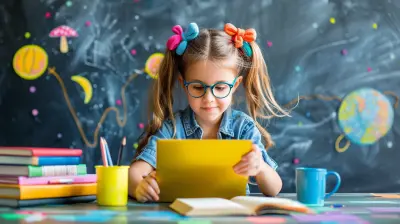The Future of Education: How Tech Tools Are Shaping Classrooms
1 November 2025
Let’s face it — the world is changing faster than ever, and education is catching up at full speed. Gone are the days when chalkboards and overhead projectors were the height of classroom tech. Today’s students are growing up in a digital world, and like it or not, education has to keep up. So many parents wonder: what does the future of education look like for our kids?
The short answer? It’s tech-heavy, connected, and interactive. But don’t worry — that’s not a bad thing. In this article, we’ll unpack how various tech tools are shaking up classrooms, transforming the way students learn, and making life a little more dynamic (and sometimes easier) for teachers and parents alike.
Why Is Technology So Important in Education?
Before we dive in, let’s be real — technology is no longer a luxury in the classroom. It's a necessity. Our kids are digital natives; they’ve grown up tapping, swiping, and Googling everything. Education simply has to keep pace.So, what's driving the need for tech in schools?
- Personalized learning is now possible.
- Students can access information 24/7.
- Teachers can deliver lessons in more engaging ways.
- Parents can keep track of their kids' progress in real time.
Think of tech tools as a bridge — connecting students to knowledge, teachers to resources, and parents to the classroom, all in a way that just wasn’t possible before.
Interactive Learning: Hello Engagement, Goodbye Boredom
Remember sitting through long lectures or copying endless notes off the blackboard? Yeah, not exactly thrilling. Today’s classrooms look very different.Smartboards and Touchscreens
Interactive whiteboards are replacing static chalkboards. These digital boards let teachers pull up websites, show videos, and even let students solve math problems right on the screen. It’s hands-on learning, quite literally.Gamification of Education
Who says learning can’t be fun? Educational games are now a major part of tech-integrated classrooms. Platforms like Kahoot!, Prodigy, and Duolingo make learning feel more like playtime. The result? Better retention and actual excitement around the learning process.Virtual and Augmented Reality
AR and VR might sound sci-fi, but they’re already being used in classrooms. Imagine your child exploring the pyramids of Egypt right from their desk or conducting virtual science experiments safely. These tools make abstract concepts feel real and relatable.
Personalized Learning: One Size Doesn’t Fit All
Every child learns differently. Some kids grasp math in seconds but struggle with literature. Others are visual learners, while some learn better by listening. Here's where tech really shines.Adaptive Learning Software
Programs like DreamBox or i-Ready adjust the difficulty level based on your child’s performance. It’s almost like having a personal tutor sitting beside them. Instruction is tailored in real time, so no one gets left behind or feels bored.Data-Driven Insights
Tech tools collect valuable data on how students are performing. Teachers no longer have to rely solely on gut feeling or pop quizzes. They can see real patterns — who’s struggling, who’s excelling, what topics need a review. The result? More effective teaching and better outcomes.
The Rise of Remote and Hybrid Learning
2020 changed us all. When schools shut down during the pandemic, we got a crash course in remote learning. And while many parents (yep, probably you too) struggled with Zoom fatigue and juggling work-from-home responsibilities, remote learning also revealed that education doesn’t have to be tied to a physical classroom.Flexibility and Accessibility
Tech tools allow students to learn from anywhere — whether it’s due to a snow day, illness, or travel plans. Children with health issues or special needs can receive education that fits their circumstances without being left behind.Video Conferencing and Learning Platforms
Zoom, Google Classroom, Microsoft Teams — these platforms have become household names. They offer structure, communication, and the chance for live interaction, even remotely. That consistency matters when it comes to learning routines.Recorded Lessons and Asynchronous Learning
Not all students work at the same pace. With recorded lessons, kids can pause, rewind, and revisit parts of a lesson they didn’t quite get the first time. It makes catching up easier and reduces the pressure to "get it" in real time.Teacher's Best Friend: Tech Tools That Make Teaching Easier
Tech isn't just transforming how students learn — it’s changing how teachers teach too. And let’s be honest — teachers have a tough job. If we can make their lives a bit easier, why wouldn’t we?Automated Grading and Feedback
Grading hundreds of assignments? No thanks. Tools like Google Forms and Edmodo can auto-grade quizzes and even offer instant feedback to students. It saves time and keeps learners in the loop.Classroom Management Tools
Apps like ClassDojo allow teachers to keep track of behavior, participation, and assignments. They can send updates to parents in real time — a huge step forward from the days of paper report cards stuffed in backpacks.Content Creation and Curation
Sites like Canva for Education, Nearpod, and Edpuzzle let teachers craft visually appealing, interactive lessons. It’s like giving teachers a digital toolbox filled with creativity boosters.Empowering Parents Through Tech
Tech doesn’t just benefit students and teachers — it brings parents into the loop like never before.Real-Time Progress Tracking
Platforms like PowerSchool or Seesaw let parents peek into their child’s academic world. You can see assignments, grades, teacher comments, and even classroom photos. No more surprises at parent-teacher conferences.Communication Made Easy
Remember writing notes in the school diary? That’s history. Messaging apps and digital portals allow instant communication between teachers and parents. Quick check-ins, questions, or updates are now just a click away.Supporting Learning at Home
Tech tools provide access to resources and learning materials that parents can use at home. Whether it’s a math app or a reading playlist, you can support your child’s learning journey even outside the classroom.Challenges and Considerations (Because It’s Not All Sunshine)
Okay, before we go full-throttle into the tech revolution, let’s talk about the bumps in the road.Screen Time Overload
Too much screen time has always been a concern for parents, and with tech-based learning, that’s a valid worry. Balance is key. Incorporating tech doesn’t mean ditching traditional methods altogether — mix it up!Inequity in Access
Not every student has a tablet or high-speed internet at home. The digital divide is real. Schools and governments need to step up to ensure all kids have the tools they need to succeed.Teacher Training
Let’s not assume every teacher is a tech wizard. Proper training is crucial to ensure that these tools are used effectively and confidently. Otherwise, even the flashiest tech becomes just another unused gadget.So, What’s Next? A Peek into the Future
We’re just scratching the surface. The future of education promises even more innovation.AI-Powered Classrooms
Artificial Intelligence is coming to classrooms near you. Think intelligent tutors, voice-activated help, and emotional recognition software that adapts based on a child's mood or engagement level.Blockchain for Record-Keeping
Sounds futuristic, right? Blockchain can securely track educational records, achievements, and certifications — all in one digital file that can’t be tampered with.Global Classrooms
Tech breaks down borders. Your child might collaborate on a science project with students in Japan or participate in a virtual global debate. Cultural exchange and global awareness? Yes, please.Final Thoughts
The future of education isn’t just about fancy gadgets and apps — it’s about creating learning environments that adapt, engage, and empower. Tech tools are not replacing teachers or traditional learning; they’re enhancing them. The goal is the same as it’s always been: help students succeed, grow, and develop into curious, capable humans.If we use tech the right way — with balance, purpose, and inclusion — we’re setting our kids up for a brighter, smarter future. As parents, it’s up to us to stay informed, stay involved, and most importantly, stay open to the changes ahead.
Because the classroom may look different, but the mission? It stays the same.
all images in this post were generated using AI tools
Category:
Tech And KidsAuthor:

Noah Sawyer

